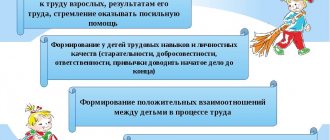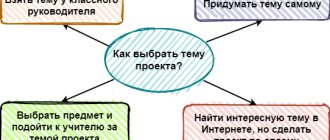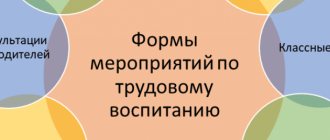MAGAZINE Preschooler.RF
At preschool age, the formation of basic types of activity, including labor, occurs. Therefore, labor education of preschool children is one of the leading directions in the pedagogical process of preschool educational institutions. At present, the place of labor in the pedagogical process of kindergarten has been determined, and its content has been developed. In the Encyclopedic Dictionary, the concept of “labor” is interpreted as “purposeful human activity aimed at modifying and adapting objects of nature to satisfy one’s needs.” The importance of labor as a factor in the development of a child’s personality is reflected in the history of Russian pedagogy: the works of P.P. Blonsky, N.K. Krupskaya, A.S. Makarenko, V.A. Sukhomlinsky, S.T. Shatsky and others. The theoretical justification of labor education with practical recommendations is covered in the works of P.R. Atutova, S.Ya. Batysheva, K.N. Katkhanova, V.A. Polyakova and others N.K. Krupskaya in her works repeatedly emphasized the need to accustom children from an early age to the simplest types of work available to them, noting that in this way they become familiar with the properties of materials and learn how to work with various tools. In their work, children show activity, ingenuity, perseverance, a desire to achieve results, and they develop a desire to provide all possible assistance to adults. Of particular importance to N.K. Krupskaya emphasized the unification of children in work, pointing out that “the joint work of children should be especially valued - these are the beginnings of collective work. It is in this collective work that the child’s strengths are best developed” [1,54]. A.S. Makarenko said that labor is the basis. But what labor is is not at all what a child’s hands are occupied with. Labor is what develops a little person, supports him, helps him assert himself. Hard work and the ability to work are not given by nature, but are cultivated from early childhood. Work must be creative, because it is creative work that makes a person rich spiritually. Work develops a person physically. And finally, work should bring joy, happiness and prosperity. We can also say that work is the manifestation of people about each other. Labor education is a purposeful process of forming in preschool children a conscious attitude and inclination to work as a basic life need, as well as the formation of a habit of work by including the child in active work. The goal of labor education for preschool children is to form children’s ideas about the work activities of adults, to develop labor skills and abilities, and to cultivate diligence as a personality trait [4,158]. Labor education is a joint activity of the teacher and students, aimed at developing general labor skills and abilities, psychological readiness for work, the formation of a responsible attitude towards work and its products, and a conscious choice of profession. Labor education is an important means of comprehensive development of the personality of a preschooler. The main goal of work is its educational influence on the child’s personality. Labor activity (especially at its early stages) is not stable; it is closely related to children’s games. The connection between work and play is important in preschool age - play images help children do work with greater interest. But it would be wrong in all cases to turn work into play. Labor education in preschool age is closely related to moral education: personal qualities and positive relationships between children are cultivated in work and with the help of work. Educators set themselves the following tasks: to form, firstly, such moral and volitional qualities as perseverance, perseverance, responsibility, conscientiousness, creative attitude to work, etc., and, secondly, mutual assistance, support, the ability to negotiate, the desire to teach others and learn oneself, empathy, etc. To solve these problems, various methods are used: joint activities of children, children and adults, conversations, problem situations and logical tasks, communication during the work process, etc. Work gives real results. The result of the work of preschoolers should be understood not only as material embodiment, but also as moral content: the child sees that his actions are pleasant to someone, arouse gratitude, and a friendly attitude. Such emotional reinforcement of the result of work constitutes its main pedagogical value. In order for work to become a means of moral education, already at preschool age it is necessary, along with the instillation of labor skills, to direct the child’s efforts to socially useful work, in which satisfaction with one’s activities for others is born, and an understanding of one’s connection with everyone. In work, friendly relationships are formed: goodwill, the ability to give in, provide a service, offer help. Business relationships emerge, which are characterized by the ability to distribute and plan common work, the desire to complete the task oneself and expect the same from others, to provide assistance to each other and to treat the assigned work with a sense of responsibility [3, 37]. In work, preschoolers successfully learn and reinforce moral standards of behavior. Analysis of the possibilities of work activity of preschoolers for their aesthetic development: familiarization with the work of adults, the content and nature of the performance of work tasks. In the process of aesthetic education, it is important to introduce children to the work of people in creative professions: writers, musicians, artists, masters of applied arts. Methods of introducing children to people of the named professions. Compliance with the principle of quart: creator, interpreter, listener, child performer. The connection between the parts of the quart: the composer composed the music, the interpreter performed it, adults and children listened, the child tries to compose music himself. The same is true for other types of creative activity. Particular attention is paid to the fourth part - the own activities of preschoolers. Here an aesthetic attitude towards completing a task is formed: not just to depict something, but to do it beautifully; find the most attractive option for crafts made from natural material, paper. The teacher instills in children the ability and desire to include elements of aesthetics in household work, self-service, work in nature, teaches them to evaluate the results not only by what happened, but also how aesthetically the work was done, how much invention, creativity, and independence the child showed. Aesthetic education in work is also carried out through teaching children to order in the arrangement of tools and tools. Aesthetic education is also facilitated by working with music, during which children receive satisfaction and pleasure [3, 39]. Studying at school will require a lot of volitional and physical effort from the child, the ability to conscientiously and responsibly carry out tasks, plan their activities and anticipate their results. All these skills are successfully instilled in preschool age. Formation of motives for work activity (work to achieve a positive result, for the benefit of oneself and for other people). Exercise in achieving a positive result in work as the leading method of raising children (calmly redo poorly done work, try to finalize details slowly, carefully and accurately, etc.). Accustoming to mental work (solving logical problems, puzzle problems, joke problems, searching for an answer to a question of interest in a book, making crafts and subsequent analysis of the work process). Experimentation and experiments as a means of mental education in work. Formation of interest in the thought process and a feeling of satisfaction from an independently found solution. Developing the ability and need to keep your workplace in order, take care of your appearance, etc. Accustoming a child to life according to a schedule and independently finding a place for work and rest. Reasonably organized work strengthens the physical strength and health of the child. Movements become more confident and accurate. By acting, the baby becomes increasingly better oriented in space [3, 36]. To date, the place of labor in the pedagogical process of kindergarten has been determined, its content has been developed (E.I. Korzakova, V.G. Nechaeva, E.I. Radina, etc.); forms of organization of children in labor are highlighted (Z.N. Borisova, R.S. Bure, A.D. Shatova); the process of forming a positive attitude towards the work of adults is studied (V.I. Glotova, V.I. Loginova, YaZ. Neverovich, A.G. Tulegenova, M.V. Krulekht, etc.), the features of labor education of preschool children in the family are considered (D O. Dzintere, L.V. Zagik, T.A. Markova), the influence of work on the development of moral and volitional qualities of children, their relationships is studied (R.S. Bure, G.N. Godina, A.D. Shatova and etc.). Of no small importance are the studies of Ya. Z. Neverovich, T.A. Markova, who showed that the main motive that encourages children to work is their desire to help adults. In preschool pedagogy, three ways of bringing children closer to the work of adults are identified: observation of work, partial assistance from children to adults, and organization of joint activities of adults and children (V.I. Glotova, L.V. Zagik, S.M. Kotlyarova, G.N. Leskova, E.I. Radina, D.V. Sergeeva and others). According to E.I. Radina, in joint work an adult can act as a role model not only with his skills, but also with his attitude to work. Thus, scientists have made a significant contribution to the development of the problem of identifying the signs and components of hard work in preschool children. However, the problem of instilling hard work in preschoolers as the main personality quality has not yet been sufficiently developed. The hard work of preschoolers is organically connected with other personality qualities. Thus, interest in the activities of adults, the relationship between children and adults, careful attitude towards the products of labor is nothing more than humanism; conscious fulfillment of one's duties is responsibility; cooperation between children, adults and children - collectivism; the ability to complete a task reflects the degree of diligence, perseverance, and determination. Consequently, hard work is a quality that reflects the development of the individual as a whole. Theoretical foundations of instilling hard work in preschool children [2, 34]. Labor education is the most important component of preschool education, the basis for the development of a child’s creative abilities, and the most important means of developing a culture of interpersonal relationships. The tasks are set to develop in children (taking into account age-related capabilities) an interest in the work of adults and a desire to work; education of basic labor skills and hard work. These tasks are solved through familiarizing children with the work of adults and through their direct participation in feasible labor activities in kindergarten and at home. The role of familiarizing children with the social orientation of work and its social significance is emphasized; formation of respectful attitude towards working people. In each age group, the types and content of labor activity are determined, as well as the tasks that are solved in the process of child labor. By organizing work activities, the teacher ensures the comprehensive development of children, helps them gain confidence in their abilities, promotes the formation of vital skills and abilities, instilling responsibility, independence and a value-based attitude towards their own work and the work of other people.References: 1. detimami.ru/trudovoe-vospitanie-detej - Labor education of children. How to instill hard work. 2. Lobanova E.A. Preschool pedagogy: educational and methodological manual / E. A. Lobanova. - Balashov: Nikolaev, 2005. - 76 p. 3. Markova T.A. Fostering hard work in preschoolers. – M.: Education, 1991 4. Vasilyeva, M.A. Labor education / M.A. Vasilyeva // Preschool education. - 2005. - No. 4. — P.18.
| Next > |







